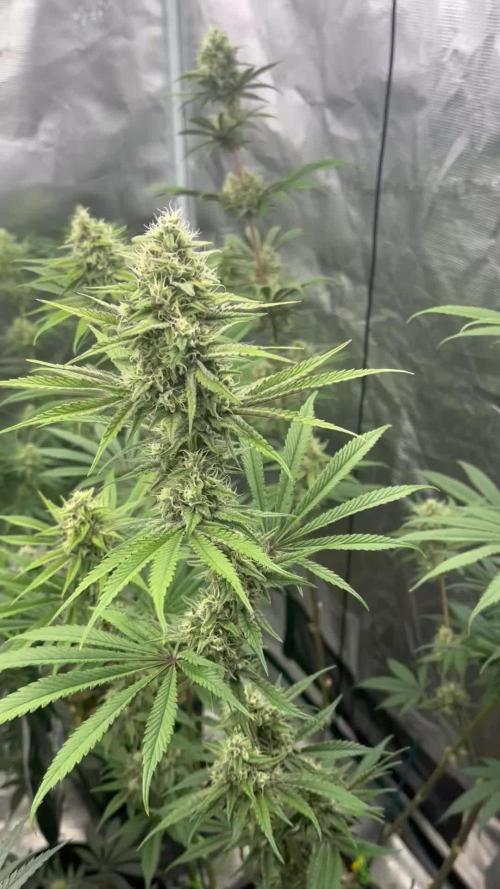The Grow Awards 2026 🏆 



























Likes
Comments
Share


@Grey_Wolf
Follow
I smell dogshit 💩
Connoisseur genetics Dogshit deadhead haze
24th Jan 2022
This will be the last week of veg as she transitions into flowering 😀
I dosed her up with enough Bio bloom to last the first 6 weeks then by then I should have some guano
I really hope those long branches fill in nicely with bud rather than being airy we'll have to wait and see.
Thanks once again for stopping by 👍
Likes
11
Share


@TheThiccBud
Follow
i'm sorry that my english sounds like a grass trimmer XD
This Plants are growing Perfekt. She is just a beauty <3
Its the first time i am useing 50l Pots. and i have to say they are damn good ^_^
and the smell of the plant is turning to a sweet citrus @_@.
More information will be available next week. Then also without light -_°
Likes
40
Share


@Coopmc
Follow
Looking like 2 more weeks to Glory!!
Oh yes this looks good!
Looks like a bit over a week left maybe 2
Likes
13
Share


@CalimannpackZ
Follow
Sorry I didn’t upload week 5 Ngl it was a bad week i suffocated 4 plants I had to defoliate some leaves because of nutrient defeincies making the plant look diseased I managed to pull through there back healthier again I got a few yellow spots but there goint but other then them 4 there’s some nice bud and bud spots really starting to come through excuse the 4 shittier looking plants and the defoliated skimpy one! Other then those problems that I have resolved I’m happy again last week not so this week happy!!! It’s all trial and error first go I haven’t trained any plants I will do on my next grow definitely!
Likes
1
Share


@bigsmoke42069
Follow
Week 7 of flowering 10/30/24
Changed nutrients to fit week 7
Buds are getting even bigger and thicker.
Last week PH drop happened again a couple of days after the major flush.
PH in rootzone is getting lower every day.
Runoff still at 10-20%, so no salt buldup, EC same as intake or litttle higher.
Flushed again with FloraKleen and watered with TriPart Micro, Grow, Bloom with CalMag.
Bought Potassium Bicarbonate and Calcium Carbonate as suggested by "Aqua Man", to buffer coco in the future. (https://www.thcfarmer.com/threads/ph-dropping-from-5-8-to-3-9-overnight-what-is-causing-this.87011/post-2329509)
changed nutes on 11/2/24, to FinalPart at 1.3 EC.
Checking runoff PH and EC daily.
Likes
29
Share


@SalocinSpecial
Follow
***Note that I started to count the days when I placed the seeds between paper towels. The seeds were planted 3 days later and sprouted from the ground 2 days after being planted.
D63 (26/04/2021) : I top dressed the soil of every pot with Gaia Green power bloom 2-8-4, earthworm casting, bone meal and shrimp compost. I think it was a bit late in the flower to top dress the Glue Gelato. From now on I will only give water.
D66 (29/04/2021): I saw more calcium deficiency but on the Banana Kush this time. She is really close from the light and I think this is why the closest leaves got some rust brown ish spots. The lamp under the Banana Kush and the Gelato is higher now. I made a gallon of home made organic CalMag supplement with Epsom salt, crushed egg shell and molasse. I gave all 3 plants 200ml of home made CalMag when watering them. I will gave them approximately 100-150ml of this CalMag supplement every other watering.
D69 (02/05/2021): The smell is crazy 😍 It smells soooo good! The house is starting to smell strong too 😳😅.
- Light: the lights are at 100% and at 12 inch form the plants.
- Temperature: during the day: 24-26C ; during the night: 20C.
- Humidity: the humidity is maintain around 46-48% all the time.
- Air circulation: There is an oscillating fan on the ground, one fixed fan pointing on top of the canopy and one fixed fan to help cool the lights.
- Water: I gave water every other day or when the ground feel dry or the pots feels light.
Likes
14
Share


@AmnZhz
Follow
Week 11 16/12/2018 - 23/12/2018, cant wait to harvest everything is frosty and the smell is just perfect. Hopefully this will be the last week and the next one i ll start flushing. Waiting till the end of next week. Checked the trichromes couple of days ago and they were still transparent. Will check again in a couple of days to see if they turned cloudy.
Likes
6
Share


@ganjaman24
Follow
All in all every strain is doing great! Blueberry is the closes to finishing followed by chemdawg and lastly the Somango I just flipped little over a week ago so still have a little while to go with her! Blueberry has a pungent and fresh berries/citrus aroma going on while the chemdawg has the infamous og odor no doubt og is related to it haha. Thanks for checking it out! XD ..sorry for the delayed update
Likes
36
Share


@pifflestikkz
Follow
Day 99
09/08/24 Friday
Feed today, using de-chlorinated tap water pH 6, no plagron products this week due to seeing nute burn.
But she has bounced back yet again from a heavy defoliation and topping last week.
Trying to keep her small enough to flip in the tent 🤞
Day 100
10/08/24 Saturday
Picture and video update ✌️ 💚
Day 101
11/08/24 Sunday
De-chlorinated tap water pH 6 today again with calmag.
Day 102
12/08/24 Monday
De-chlorinated tap water pH 6 today again with calmag and Plagron PK13-14 5L 10% run off
Just trying to maintain her still untill my dragon has finished 🤦♂️
Thriving 😍✌️💚
Likes
31
Share


@RFarm21
Follow
Semana 9 ( 3dez - 9dez)
Alimentada dia 5 dezembro.
Runoff EC: 1.60/ pH: 6.4
5dezembro - regada com 1l de água. pH 6.0
Likes
8
Share


@HandsomeTerpz
Follow
The buds are swelling nicely 🌱💨 and developing super well the terps are turning out amazing! 😍✨
Likes
61
Share


@Captensmokey
Follow
This week it was cold. The cold weather stops the good flowering growth. But we keep going.. We have no choice. I do my best to make everyone happy and inspire them to do the same. You can see what I use and what the results are. Green regards capten smokey😁
Likes
17
Share


@Neodamis
Follow
Added nutes on 10/17, 30ML of Fox farm organic big bloom and 4ML of Fish shit to one gallon and fed them all that entire gallon.
10/20 Couple days after the nutes and they exploded!
Likes
16
Share


@Reddgrower
Follow
Got everything hung up. Stripped the fan leaves and broke down into sections. Run 60/60 or as close as i can get until the stems snap.






























